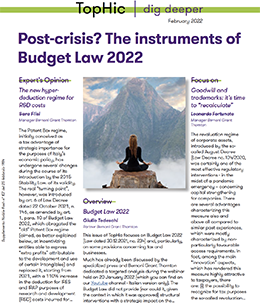-
Transactional advisory services
Find out more about the transactional advisory services of Grant Thornton Financial Advisory Services
-
Valuations
Find out more about the valuations services of Grant Thornton Financial Advisory Services
-
Mergers and acquisitions
Find out more about the merger and acquisition services of Grant Thornton Financial Advisory Services
-
Forensic and investigation services
Find out more about the forensic and investigation services of Grant Thornton Financial Advisory Services
-
Recovery & reorganisation
Find out more about the Recovery & reorganisation services of Grant Thornton Financial Advisory Services
-
Business risk services
Find out more about the business risk services of Grant Thornton Financial Advisory Services
-
Business consulting
Find out more about the business consulting services of Grant Thornton Financial Advisory Services
-
Capital market
Capital market
-
Corporate and business tax
Find out more about our corporate and business tax services.
-
Direct international tax
Find out more about our direct international tax services.
-
Global mobility services
Find out more about our global mobility services.
-
Indirect international tax
Find out more about our indirect international tax services.
-
Transfer pricing
Find out more about our transfer pricing services.
-
Litigation
Our lawyers and accountants can manage all defense measures provided not only by the Italian law, but also by EU regulations and conventions
-
Family business
Find out more about our Family business services.
-
Legal
The client can be assisted in every need and with the same care both on important operations or disputes and on simple matters

-
Back office outsourcing
Find out more about our Back office outsourcing services
-
Business process outsourcing
Find out more about our business process outsourcing services.
-
Compilation of financial statements
Find out more about our compilation of financial statements services.
-
Tax compliance
Find out more about our tax compliance services.
-
Electronic invoicing
Find out more about our electronic invoicing services
-
Electronic storage
Electronic storage is an archiving procedure that guarantees the legal validity of a digitally stored electronic document
-
Revaluation of corporate assets
Find out your civil and fiscal revaluation of tangible, intangible and financial assets
-
Human resources consulting
Find out more about our human resources consulting services.
-
Payroll
Find out more about our payroll services.
-
HR News
HR News the monthly information newsletter by Grant Thornton HR
-
Cybersecurity
GT Digital helps clients structure information security management internal functions, also through partially or totally outsourced functions
-
Agile and Programme Management
GT Digital provides support in the adoption and implementation of different portfolio management
-
Robotic Process Automation
Our “BOT Farm” can rely on digital workers able to help clients in routine activities, allowing employees to deal with more added-value activities
-
Data strategy and management
GT Digital can support clients in seizing the opportunities offered by Big Data, from the definition of strategies to the implementation of systems
-
Enterprise Resource Planning
We support clients in selecting the most appropriate ERP System according to their specific needs, helping them also understand licensing models
-
IT strategy
GT Digital supports clients in making strategic choices, identifying innovation opportunities, comparing themselves with competitors
-
IT service management
We can support with software selection and with the implementation of dedicated tools for the management of ICT processes
-
DORA and NIS 2
The entry into force of the DORA Regulation and NIS2 represents a major step towards the creation of a harmonised regulatory framework
This issue of TopHic focuses on Budget Law 2022 (Law dated 30.12.2021, no. 234) and, particularly, on some provisions concerning tax and businesses.
Much has already been discussed by the specialized press and Bernoni Grant Thornton dedicated a targeted analysis during the webinar held on 20 January 2022 (which you can find on our Youtube channel).The Budget Law did not provide (nor could it, given the context in which it was approved) structural interventions with a strategic impact on the management of Italian companies.
In this issue, two of the most debated topics have been selected: the Expert's Opinion analyses the new Hyper-deduction regime for research and development costs introduced to replace the old Patent Box regime; the Focus On article analyses the restrictions implemented "on the run" and the tax revaluation of trademarks and goodwill, after many companies last year exercised the option offered by the previous legislation. While this introductory Overview outlines the economic context in which the Budget Law 2022 is inserted.
Such context is one oriented towards recovery and based on virtuous behaviours of companies, mainly middle ones, which characterize the Italian economic system, and on taxation for investors.
Non-repayable interventions are no more sufficient. Companies need to recovery the balances suspended due to the emergency period; it is necessary to move towards a system where the recovery is led by the State with structural aids that provide, for example, for access to capital on the condition that private investors enter under the same conditions.All this according to an industrial policy and no longer to simple disbursements of funds.
In fact, the time to repay the funds granted during the first emergency period has now come. The quantity of debts to be repaid as of 1 January 2022 is huge, given the termination of the moratorium periods established by the first Covid-19 emergency laws, was news (the data was reported in the specialized press based on information provided by the liquidity task force that highlighted the number of payments suspended at 31 December 2021, which is the termination date of the moratoriums supported by a public guarantee).
The suspended loans of companies that had not made payments have been estimated as equal to approximately 36 billion; therefore, we can observe a scarce availability of effective tools to support companies that are unable to make payments.
On the one hand, this situation shows the risk for public accounts due to interventions resulting from the guarantee granted; on the other hand, it shows the risk for companies of not being able to meet the ordinary deadlines which, from a financial point of view, also affect the ordinary need to support working capital.Now, speaking about the provisions contained in the Budget Law, we would like to summarize some general considerations that could be in line with this "recovery" path:
- the reduced registration, mortgage and land registry taxes at a fixed rate for the transfers of instrumental properties within company transfer contracts (Article 1, para. 224 and subsequent of the Budget Law). This is an important benefit, at least with regard to its extent, since the payment of the proportional tax is not required as it generally happens. The reduction, however, is applied on the condition that the deeds of sale are stipulated as part of plans aimed at supporting employment levels and business continuity. The latter aspect has already been specified by the Revenue Agency in recent circular letter number 3 of 2022;
- the confirmation and extension of the terms for the granting of tax credits against investments in so-called 4.0 tangible and intangible capital goods (art. 1, para. 44 et seq. Budget Law). The benefit is part of the investments aimed at the ecological transition, digital development and internationalization processes. The recent "Sostegni ter" law decree, by adding a new paragraph to the regulatory framework, selects, within eligible assets, a specific category for investments aimed at achieving ecological transition objectives by assigning new thresholds. These interventions are especially significant if we also consider the scope of digital innovation activities (which are required both due to entrepreneurial development needs and due to the scope of interventions included in the NRRP);
- the extension of the tax incentive for business combinations (Article 1, para. 233 et seq. of the Budget Law). The extended incentive is that allowing the party resulting from the business combination (merged or acquiring company, beneficiary company or transferee company) to transform the deferred tax assets (so-called "DTA") referring to previous tax losses and unused ACE surpluses into immediately usable tax credit. In order to benefit from the incentive, the merger, demerger or company transfer operations must be approved by the competent corporate bodies between January 1, 2021 and June 30, 2022;
- from a financial point of view, we remind the additional allocation of the Fund made available to companies targeting foreign markets. This is the so-called support for business internationalization. The measures concern three areas: (i) digital and ecological transition of SMEs with an international vocation, (ii) participation of national SMEs, also in Italy, in business missions and (iii) development of electronic commerce of SMEs in foreign countries. The aims of these interventions are also taken into consideration in the NRRP. The measures for businesses, managed by Simest, concern two areas: one dedicated to loans, the other one to non-refundable grants;
- again, from a financial support point of view, new funds have been allocated for the so-called "Sabatini Law". This law provides three different measures: (i) a loan disbursed before the investment is made, (ii) the free guarantee by Mediocreditocentrale for companies that have not exceeded the 5 million ceiling and (iii) a non-refundable contribution. This last one is provided directly by the Italian Ministry of Economic Development. The maximum amount of the subsidy is equal to the value of the interest calculated on a five-year loan for an amount equal to the investment made.
These are some of the support measures provided under the 2022 Budget Law. Thanks to them, economic operators can implement development projects and interventions to seize the recovery opportunities that may derive from a proactive management in this historical moment. Obviously, these aids cannot represent the only tools to be used to plan relaunch and development actions, but must be integrated according to a "multidisciplinary" approach to a conscious management that need to be well studied and planned.
In this phase, therefore, it is necessary to take actions to support a conscious management and plan investments useful to recover, according to sustainable financial dynamics, seizing the opportunities that arise in this historical phase. This must be made based on an adequate risk management, including that concerning IT security and digital development.

